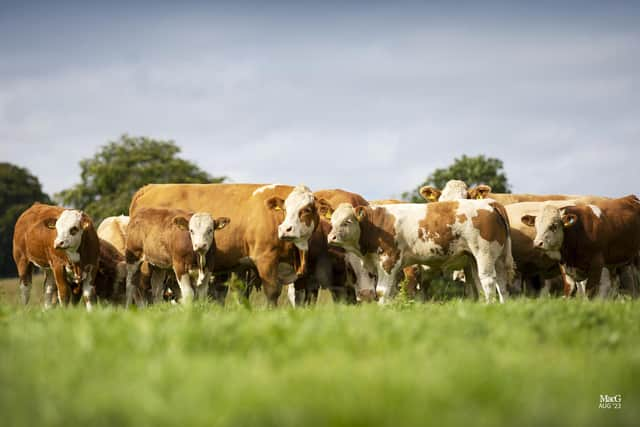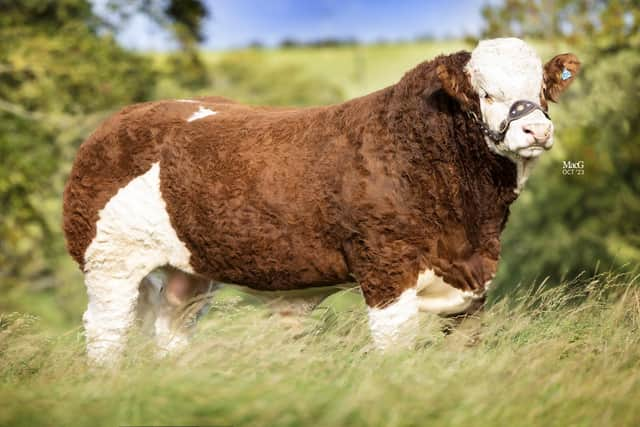Satisfied by the Simmental
and live on Freeview channel 276
Colin McKee describes himself as a now, part-time animal nutritionist and full-time farmer, which is suitably accurate as he manages 23 suckler cows and heifers and 150 breeding ewes outside of his 9-5. With a backdrop of Slemish mountain, Colin farms at Buckna outside Broughshane, over approximately 100 acres and an additional 40 acres of rented land split into four grazing blocks.
Although Colin was pleased with his calves previously, he felt that his beef system was missing an element of hybrid vigour. The females in his herd, of mostly Limousin breeding, are well-shaped but he looked to Simmental for milk and further growth traits to meet this gap. Since having a well-established relationship with the Robson family through his work, he purchased Kilbride Farm Lamotte as his new stock bull in 2022. He is in the top 15% of the breed for 200 and 400 day weight and top 5% for maternal milk which he hopes will prove successful in his herd.
Advertisement
Advertisement
In February 2023, Colin went through major surgery and was forced to step away from the farm as the calving period approached and employ outside help. All females calved themselves and produced flashy, nicely marked calves which was a huge positive for his business. In his first calving season using Simmental genetics, direct calving ease and growth have both shown promise.


As Colin operates a one-man system, he focuses on maintaining a tight, six-week calving block, from late February until early April whilst also balancing this with his lambing period. During the service period in early June, he ensures his cows are provided with 1kg/day of meal which includes magnesium and high fertility minerals. This improves conception rate and maintains body condition; it also is beneficial when moving cattle and monitoring oestrous activity. Cows and calves are grazed rotationally in paddocks from May until mid-October where calves are creep fed and are provided with 1.5kg/day meal from mid-July onwards. Creep gates are in place between paddocks, allowing calves to always have access to high quality grass.
Calves are weaned at the end of the grazing period, they are brought in and housed separately from their mothers. Males are squeezed at two months old so they can run together with the females at grass and all stores are sold at 17 months of age. Colin aims to keep his own replacement heifers and will select these based on temperament and maternal characteristics.
Colin noted significantly higher weaning weights since integrating Simmental genetics into his herd. In 2023, his average weaning weight for steers was 350kg and 310kg for heifers which was notably higher than that recorded in previous years. In 2023, calving index was 376 days and the projected index for 2024 is 368 days based on service dates and pregnancy diagnosis results.
Advertisement
Advertisement
In terms of future plans, Colin hopes to maintain his breeding herd, but he is considering downsizing slightly to approximately 21 females to further reduce stress and workload. However, Colin believes “Simmental will definitely remain a feature in the future of the herd”.


Analysis of AHDB’s National Beef Evaluation (NBE) data has shown that Simmental sired progeny have a superior Daily Carcase Gain in comparison to Continental sired, and Native sired progeny.
This latest analysis is in addition to the first release in October 2023, which showed that Simmental sired calves finished on average over five weeks earlier than those by all Continental sires, with these calves costing on average over £70 less to finish, and resulting in significantly reduced CO 2 emissions.
Furthermore, Continental sired calves out of Simmental dams finished over four weeks earlier than the average of all suckler dams. With regards to maternal traits, the average genetic merit for Simmentals is also shown as higher than the average for all Continental breeds.
Advertisement
Advertisement
The ‘ultimate combination’ for Daily Carcase Gain is shown as the progeny of a Simmental bull out of a Simmental dam. Emphasising the strength of the Simmental breeds maternal qualities, the highest rates of Daily Carcase Gain are attained by both Continental and Natives sires for progeny out of Simmental dams.
The NBE dataset is collated nationally from BCMS, as well as many of the UK’s largest processors and abattoirs to develop a database that includes records from over three million animals slaughtered in the last 10 years. This huge dataset is enabling AHDB to estimate the genetic merit of beef cattle, including over 500,000 sires, for days to slaughter, carcase weight and EUROP scores.
The data again shows that Simmentals rank highly amongst Continental breeds for this trait, age at slaughter, (December 2023) and have on average, a leading genetic merit for reducing days to slaughter. The actual performance data of Simmental bred offspring translates to actual performance as follows.
- Simmental sired calves finish on average 37 days earlier than those by Continental sires and 46 days earlier than calves by native sires.
Advertisement
Advertisement
- Simmental sired calves will cost on average, £74 less to finish than the average of all Continental sired calves, assuming £2 per day finishing cost.
- Simmental sired animals, finishing 37 days earlier, will on average produce 5.6kg less CO 2 equivalents based on UK Government’s estimate the average animal produces 151g of CO 2 equivalents per day.
Commenting BSCS President Norman Robson said: “These Simmental advantages are massive and really add up to money for commercial producers. If you’re finishing 100 cattle then by using Simmental genetics its reducing your number of days feeding by 3700 to 4600, that’s £7400 to £9200 assuming a conservative £2 per day finishing cost! Similarly it’s a reduction of 592kgs to 696kgs less CO2 emissions meaning real environmental sense for retailers and society.”
It’s important to remember that a bull only provides half of the genetics inherited by a calf. The other half comes from the dam. Again, Simmental bred calves are shown as the most efficient.
Advertisement
Advertisement
- Calves out of Simmental dams and by Continental sires finish on average 47 days earlier than the average of all dams, showing that choosing Simmental cows is another great strategy to reduce finishing costs.
- In every example given in Fig 2 calves out of Simmental dams finish significantly earlier than calves out of All Dams, and Suckler Dams.
- Again, the ‘ultimate’ combination for age at slaughter can be seen as progeny sired by a Simmental bull and out of a Simmental dam at 633 days.
MAXIMISING SIMMENTAL GENETICS
A great way to further leverage this Simmental advantage is to select your sire according to his EBV.
Advertisement
Advertisement
Using a Simmental sire in the top 10% for days to slaughter, Simmental sired calves finish on average 45 days earlier than those by Continental sires and 54 days earlier than calves by native sires.
Commenting further BSCS President, Norman Robson said: “We’ve been promoting Simmental as a hard-working, no nonsense beef breed that gives you more. These claims have been qualified by the analysis of AHDB’s National Beef Evaluations which are based on a vast amount of indisputable data unique to the sector.
“With input price pressures continuing to escalate, there is going to be a real premium on efficiency. Simmentals are showing here, in data over a 10-year period, that they are a future proofed beef breed fir for the modern industry. The data shows the Simmental advantages in Daily Carcase Gain; age at slaughter whether sired by a Simmental or out of a Simmental dam; and a significant reduction in finishing costs, with lower emissions meeting environmental challenges.
“The data cumulatively highlights the added value performance that can be achieved from both carcase and maternal traits when Simmental genetics are introduced to the herd. In turn, they’re the main contributors to efficiency and subsequently profit, absolutely essential going forward for a sustainable enterprise.”
- To breed animals that best suit your farming system, AHDB recommends its National Beef Evaluation EBVs should be considered in conjunction with EBVs from your performance recording organization.